
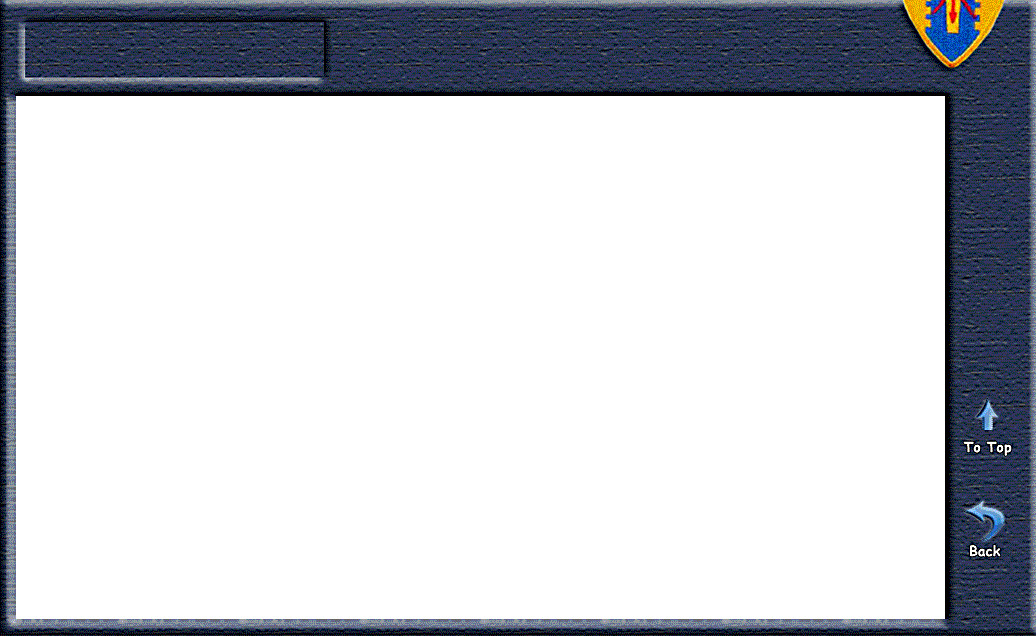
This is an essay that Bob wrote and had published in the VHPA Magazine, Sep/Oct 2013. Format adjusted for website.
Centaurs mentioned in the article: James Pyburn, Herb Beasley, Jim Peterson, and Mike Squires.
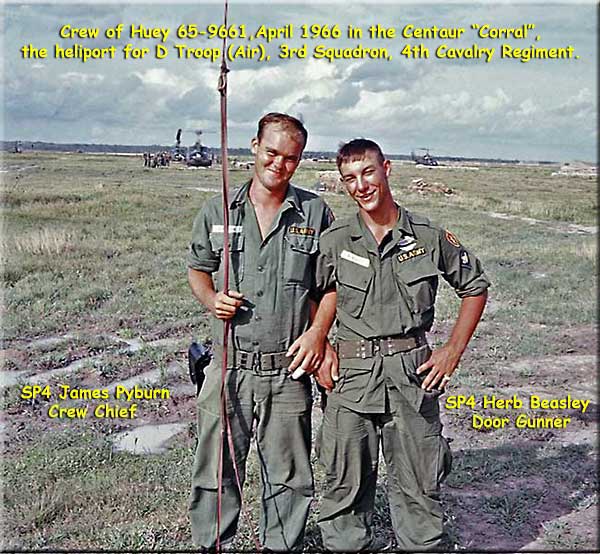 Foreword
Foreword
In order to gather critical battlefield intelligence, specially trained soldiers, Long Range Reconnaissance Patrol (LRRP) teams, are inserted by helicopter into enemy territory in a covert manner. Then after three days it is intended to take them back out as stealthily as we put them in. A reality of the Vietnam War, being stealthy in a Huey was only a state of mind. Plans don't always work out, leading to a guns blazing, “hot extraction" as we called it.
The Big Picture
The second Centaur light fire team climbed to the west over the ordered tree lines of Dau Tieng, Vietnam, and then quickly disappeared in the distance. They would link up to an ongoing LRRP insertion and the first fire team with a half hour staggered fuel reserve. I made a mental note of the time, 10:25 AM.
It was momentarily peaceful in that French colonial setting. Nearly anywhere one stood, he could quickly line up with a disciplined row of trees, no tropical brush. These were 1966 Vietnam remnants of a now past Indochina exploitation. There was pseudo serenity to the morning; it was nearly distracting to be conducting combat operations. Perhaps a warm croissant and coffee in the shade under this warm midmorning sun would have been more appropriate for the setting.
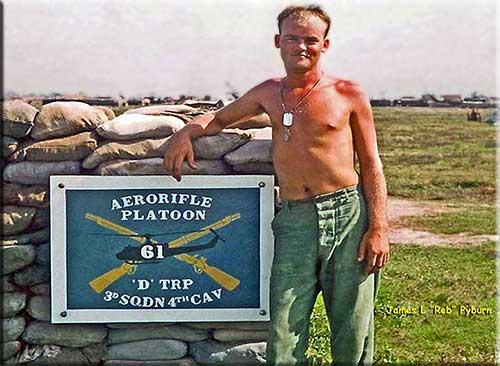
Airborne, Troop Commander MAJ Jim Peterson was executing a small, but complex daylight LRRP team insertion. During our early morning pre-planning walk and talk, reviewing the uncertainty of current intelligence and our own recent experience of increasing VC activity, he had decided not to chance a possibly compromised daylight insertion. He was apprehensive as they were to be placed near the Cambodian border. I would plan all normal D Troop quick reaction assets airborne, including the Aero Rifles. The exception, MAJ Myron”Mike” Squires with a slick, 65-9661 as a standby. Every other combat asset of D Troop (Air), Centaurs, 3rd Squadron, 4th Cavalry was at least 45 minutes flying time away at the 25th Infantry Division Cu Chi base camp.
My operations function was now minimal, that of monitoring a LRRP team already in place near the Michelin Rubber Plantation and the unfolding insertion far to the west near the Cambodian Parrot Beak. Normally, I planned and then flew the insertions.
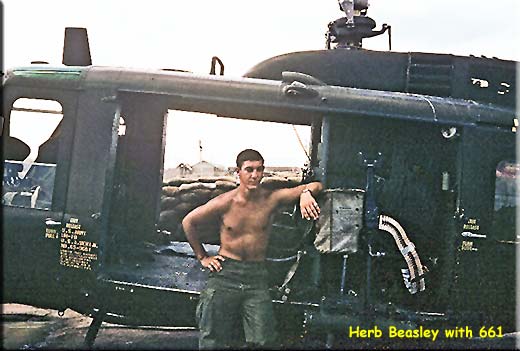 Mike Squires and I are free to listen to progress on multiple radio channels from the Tactical Operations Center (TOC) at the 25th Division’s bustling forward 3rd Brigade base at Dau Tieng. We idled, mind raced, kicked dust, and waited.
Mike Squires and I are free to listen to progress on multiple radio channels from the Tactical Operations Center (TOC) at the 25th Division’s bustling forward 3rd Brigade base at Dau Tieng. We idled, mind raced, kicked dust, and waited.
Listening to normal Centaur insertion radio chatter is not action packed drama; it is akin to watching paint dry. It’s a terse few “Rogers” during a preplanned battle drill with strict minimal radio traffic. The same is true for the LRRP team who use mike clicks to answer arranged memorized questions. The every half-hour check in is just a few mike clicks.
Drama is dry when things are going well. For a short while we have private thoughts, and then I must answer a pressing duty call and count flies in the latrine.
Compromise
Mike Squires dashed out of the 3rd Brigade TOC. “Hey, Bob! Want to go for a ride with me? Grab your helmet; let’s go. I need a copilot, right now!” The team was compromised. They requested immediate extraction. No mike clicks now. In guarded panting whispers they reported being outnumbered, conducting evasion maneuvers to the north edge of the designated extraction punch bowl, skirting the vicinity of the pickup location. To avoid a face off fire fight they were playing a running game of hide and seek maneuvers.
This hot Centaur extraction was starting after four days of LRRP team success. A fresh new team now placed near a rather dense jungle, VC high traffic trail to the northeast of Dau Tieng was compromised. It was 10:55. Nearly thirty miles to the northwest near the Cambodian Parrot Beak, a second team was airborne: an insertion in progress. It would be 11:15 for the first fire team to return for refueling. This was a not- so-good situation.
The troop was at that moment totally committed making the second insertion to the west. We did not have fire team support, a near absolute standard for all our extractions. Mike did not have a copilot for the standby extraction slick. This makes two not-so-goods, maybe even one complete “oh shit!”
As the Centaur Operations Officer, I was the only free aviator left on the ground at the forward base. It was quickly agreed, it was up to us. Quite frankly, I think Mike would have gone alone had I not agreed to fly with him. Once a team is compromised, things get worse by the minute.
Working the Problem
In the 3rd Brigade TOC, I quickly briefed the S-3 operations duty officer and the brigade’s artillery liaison officer. There was a LRRP radioman right with them. Urgently wanted were a fire team and air strikes. Our troop artillery liaison already had his coordinated concentrations and line of fire on my tactical flight map. I requested the TOC artillery liaison to connect the dots between two on-call concentrations on the north side of the pickup zone with additional planned fire so a 200-yard wall of artillery fire could be quickly placed without adjustment.
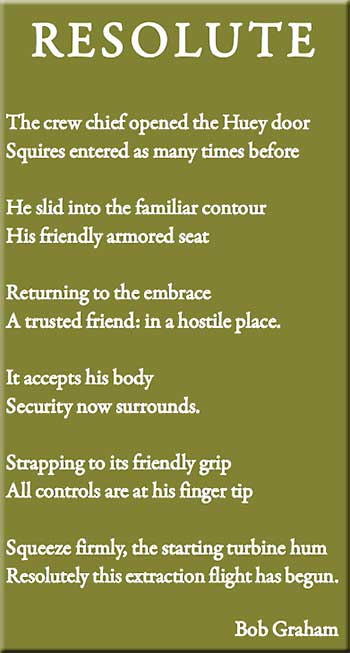
I heard the Huey coming up to full RPM! Mike was getting impatient. “I’m out of here, my friend. I’ll be on the radio with you in about two minutes checking on how you’re doing with the extraction fire support.” Mike was ready to pull pitch on Slick 65-9661. Crew chief Specialist James Pyburn was ready with his M-60 in the open left cargo door. Door gunner Specialist Herb Beasley held the right front door open, waiting at the ready with my armored chest protector.
As I slipped into the armored seat, Mike immediately pulled pitch, initiating a climb directly from the parking pad. He was smiling at my consternation of not yet strapping on my seat harness. I plugged into the intercom, and Mike, still calm, but stern, “Bob, I didn’t want to waste any more time. Those guys need to get out. Every second counts.”
I quickly settled in, shoulder harness and seat belt straps on, my tactical map available and list of radio frequencies on my knee pad. I proceeded with the fire support coordination. Then I realized that the control pedals were beyond reach. I couldn’t fly this thing if I had to.
Damn! I’m a minimum-sized aviator; the last person in the right seat had longer legs than I. Stretching and twisting was to no avail; not even my tippy toes would reach the pedals. The whole crew was having a snicker as I loosened my harness, squirming to hook my toes under the pedals and click them back to the short aviator position. Mike pretended not to notice.
We’re Going to do it This Way
Once airborne, I broadcast a blanket call on guard channel for any gunships near the Michelin Rubber Plantation. Nothing. I switched to Saigon Air Force forward air control. There was nothing available in the next ten minutes.
The extraction was in the vicinity of a highly active VC trail system along a small tributary of the Saigon River, northwest of the Michelin Rubber Plantation. The LRRP team continued evading, delaying their return to the insertion LZ for extraction.
There could be no second chance or other alternate. This sequence had to be executed at the spot planned. There was no other possible pickup spot within a mile. Mike explained, “Bob, just stay light on the controls, unless I’m shot.” That’s pretty straightforward. He reminded Beasley and Pyburn no suppress fire until we have a positive location of the evading team.
 We approached the overgrown clearing in the jungle canopy about the size of two football fields. Then a call came on guard channel by a fire team from heaven, Cu Chi’s newly arrived 116th Airmobile Company, Stingers. They had received a blanket call about our need for fire team support and were actually over our area and ready to support our extraction. Mike entered a short final for the pickup. Smoke was popped 100 yards away by the evading team. A small blue cloud appeared, expanding, drifting above the thick foliage at the edge of this low dense brushy overgrown jungle punch bowl.
We approached the overgrown clearing in the jungle canopy about the size of two football fields. Then a call came on guard channel by a fire team from heaven, Cu Chi’s newly arrived 116th Airmobile Company, Stingers. They had received a blanket call about our need for fire team support and were actually over our area and ready to support our extraction. Mike entered a short final for the pickup. Smoke was popped 100 yards away by the evading team. A small blue cloud appeared, expanding, drifting above the thick foliage at the edge of this low dense brushy overgrown jungle punch bowl.
Beasley tapped me on the shoulder and motioned for me to slide the protective wing on my armor seat forward. I nodded thanks. I notified the Stinger fire team of the smoke, and they confirmed that they already had blue smoke sighted. I asked them to stay ready, but to hold fire as we were not yet assured of the team’s actual location.
An early call for the coordinated artillery concentrations had to be delayed as the line of fire was over the pickup spot and therefore much too close for us to maneuver. There is no intercom chatter. The crew is individually focused, tense, as all aboard know we could easily be alighting atop the VC. It had happened before.
Chopping Wood
We were approaching straight into fifteen-to-twenty foot high brush. The main rotor blades started whacking off the high bushes to our front while Mike positioned the tail rotor in the only clear spot, in very high grass.
It is a disturbingly unique sound when heard for the first time. It’s sort of a loud rapid tick, tick, ticking. As the bush diameter reached about an inch, each whacked section sounded like an AK-47 round snapping by. Even though I had chopped a little wood, it was adding to the adrenaline rush to say the least. Later, I found out that the day before, the LRRP team had to actually drop about eight feet from the skids at this very spot. No wonder it had then seemed to be such a clean swift insertion.
This was surely no idyllic pickup spot. We had to hack our way to get low enough for the team to at least climb up on the skids. The concealment was excellent. We had bushes pressed against the windscreen.
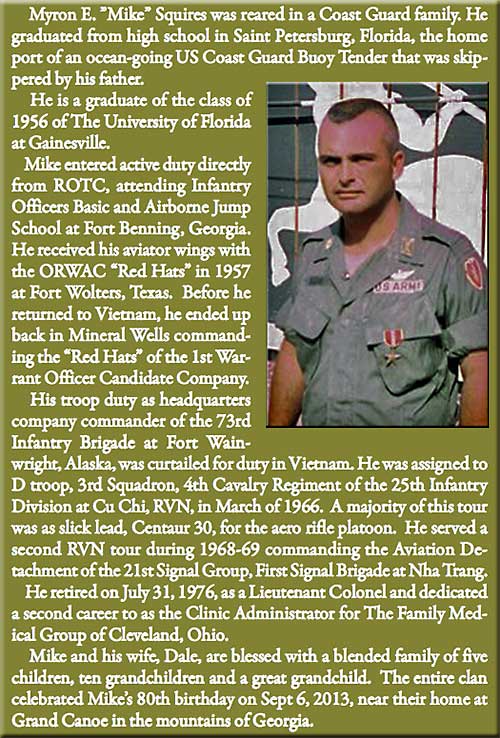 The Gatling Boys
The Gatling Boys
On the LRRP frequency, a low panting voice in the clear, ”Got you in sight, smoke behind us”. I requested the Stinger fire team to place suppressing fire beyond to the north of the LRRP smoke. They oblige. This was our first experience of the new M21 gun system with twin M134 mini guns actually firing. Gatling guns each spit blazing fire at 4,000 rounds per minute.
It was awesome as they literally mowed the heavy brush with suppressive fire. Bushes flew, and branches fell to the ground, shattered by the screaming guns of the “Gatling Boys” firing well behind the team rushing unseen toward us through the brush and tall grass.
My first visual contact over the wing of my armored seat was a red-faced, rather determined young man in the lead, crashing through the underbrush about fifty feet away. Calmly, Specialist Beasley called on the intercom, “team in sight,” and began his suppressive fire: a skillfully applied waist-high blasting arc of tracers, a short swing on each side of the team leader dashing toward him. He then applied short, carefully controlled bursts; the tracers seemed to be passing just over their bobbing heads as the team closed. My finger tips are on the cyclic following Mikes movements, just in case. Mike calmly held the Huey poised, setting lightly on the skids, waiting.
All five approached running in a close trail formation aiming to enter though the right cargo door. They literally nosedived through the door, sliding into a panting pile. Beasley was still smoking the brush close in now with his M-60, firing so close that there were ricochets spewing skyward with tumbling tracers. Without interfering, Pyburn reached under him and grabbed the last man still standing on the skids as Mike pulled pitch. He was brusquely yanked by his web belt onto the pile of smiling, sweaty guys gathering their composure on the cargo floor.
Departure
Without prompting, the team quickly seated themselves and buckled up as Mike began the takeoff. We were all startled by a sudden repetitive banging thud, a quick heart-sinking noise. The main rotor hit a substantial-sized scrub tree in our path causing the whole aircraft to shudder, sending a truly creepy sensation through my spine. Large tree pieces whirled in the rotor wash.
Deftly Mike adjusted the path of ascent; muttering to the effect, “No need to be foolish and just wack’em off on the way out. These are a new set of blades.” There is no turning back as long as the great Huey machine will continue to fly.
Pyburn and Beasley now directed suppressive fire forward and to each side of our climbing path to the Gatling Boys applied their final touch with a blazing roar. As we cleared the tree line, Mike joshed, “Bob, did I hear your voice go a little squeaky back there? Were you a little excited”? “He claimed that my voice had gone to a high pitch.” Could that have been true? I get excited, an artilleryman, a gunship person to the heart? “I loved shoot’em ups!” I told him. “Gunship people did not do such crazy things, this playing around in the bushes.” We thanked the Gatling Boys, the Stinger fire team from heaven, the strangers.
 Their reply was that they wanted to know when we were going to do this again; it was pretty cool. I gave them a second thanks and advised them of the artillery fire that would be inbound in seconds. One of the LRRP team reached over from the back and gave us both a thump on the shoulder. That’s why we were there!
Their reply was that they wanted to know when we were going to do this again; it was pretty cool. I gave them a second thanks and advised them of the artillery fire that would be inbound in seconds. One of the LRRP team reached over from the back and gave us both a thump on the shoulder. That’s why we were there!
I called for the initial preplanned artillery concentrations. First priority: fires covering the area that connected the dots, then with a five-minute pause, the entire punch bowl extraction area.
What the hell, why not shoot all the planned concentrations? That’s what the artillery was for. We did not want to leave the NVA or VC with the impression that they could just chase our LRRP teams around and not have some serious issues to deal with. As we cleared the artillery line of fire, the north side of the jungle punch bowl erupted with explosions.
Mike relaxes, glances at me and smiles. Over the intercom he compliments his crew and asks how the LRRP team is getting along. Pyburn comments, “I think a cold beer would be appreciated.” I note the time; MAJ Peterson should be landing back at Dau Tieng, and it is 11:00.
I had just experienced a first. Behind me were planning, coordinating and fire team support of LRRP missions. This was my first, hands-on, hot, long-range reconnaissance patrol extraction. A live demonstration by the distinguished crew of Centaur slick 65-9661: MAJ Myron Squires, Crew Chief SP4 James Pyburn, and Door Gunner SP4 Herb Beasley.
Copyright May 2013 Robert L Graham